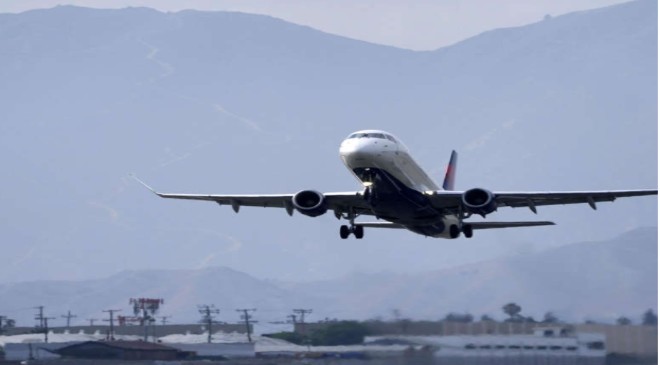Maddie Winters, a travel agent and blogger, usually racks up around 75,000 to 100,000 frequent flier miles a year. With that much time spent in airports, she relies on her memberships in programs like TSA PreCheck and Clear to save time at the airport. “[Having those memberships] makes me think I can show up at the airport later since I avoid most lines at security,” says the New Jersey–based traveler. However, on a recent trip from Los Angeles to Hawaii, a line stretching the length of the terminal to check a bag nearly cost her an on-time departure.
That all-too-common scenario is one of the issues that airports, airlines, and government agencies are hoping to solve with a burgeoning amount of biometrics, the category of technology that includes fingerprint, retinal, and facial recognition scans and helps travelers skip over lines.
“Each of us is different physically in many different ways, from the spacing between our eyes, the sound of our voice to the patterns of our fingerprints,” explains Rob Mungovan, COO at Aware, a biometrics software company. “Biometrics measures these differences and records them. This comparison of physical characteristics can be a much more secure authentication method than those used in most contemporary solutions, such as passwords.”
Since the onset of the pandemic, biometrics have proliferated in hubs across the country as a faster—and touchless—option at each stage of the air travel journey. One particularly notable new initiative is a pilot program between Delta and TSA, with a new biometric-enabled bag-drop designed to provide a seamless, low-touch experience that should take less than 30 seconds.
Here’s how it works and what else is new in biometrics for air travel.
Biometric bag drops and boarding
Delta and TSA’s new bag-drop program rolled out for testing at Atlanta’s Hartsfield-Jackson International Airport at the end of October. (A similar pilot program is also at Detroit Metropolitan Wayne County Airport.) Travelers will go to a dedicated bag drop area on the lower floor of the South Terminal. At the screen, the attached camera will automatically snap their photo and send it to the Travel Verification Service database, managed by Customs and Border Protection. Upon verification (we tried it and it took less than a second), the pending bag tags print automatically. Attach the tags, put them on the conveyor belt, and head to security like normal. “TSA has identified facial recognition as more accurate than human performance,” says Delta’s Managing Director of Airport Experience Greg Forbes. “It’s much harder to fool facial recognition than to counterfeit a drivers license. [And] it’s all touchless, all hands-free.” If you’ve opted in, you’ll also be allowed to board your flight without showing a boarding pass or other identification; your face serves as your boarding pass.
Earlier this year United Airlines announced a similar biometric-enabled, low-touch experience at San Francisco International Airport with identity management company SITA Smart Path. The program allows domestic travelers on select flights to use their face as their boarding pass for check-in and bag drop. Similarly, American Airlines offers biometric boarding at select airports including Dallas Fort Worth International. Even Hertz is rolling out fingerprint screening and facial recognition to allow rental car customers to have a faster, lower-contact experience of picking up their vehicle.
How to join: When Delta customers who have the Fly Delta app loaded with their passport and TSA PreCheck number check in for a flight, they’ll be asked if they want to use the biometric bag drop feature and confirm how many bags they want to check. You opt in each time you fly, and for now, the service is available for trips where at least the first segment is domestic. (Passengers on United or American can opt into programs with those airlines in similar ways.)
Reserve a time slot for TSA with Clear
Clear, the company which allows fliers to skip to the front of the TSA line after verifying their identity with a fingerprint or iris scan, launched a new pilot service at Orlando International airport in late October. The program, dubbed “Reservation Lane” by Clear, allows travelers to reserve a time slot to go through airport security for themselves and their travel companions. The best part? The new service is free for all.
How to join: To use Reservation Lane, travelers simply go to the program’s page on Clear’s site, reserve.clearme.com, enter their flight details and the number of travelers in their group, and choose from a list of times. Once the booking is complete, the company sends a confirmation email with a QR code. At the airport, fliers will follow signs for the Reservation Lane, have the QR code scanned by Clear staff, and proceed through a fast lane rate to TSA screening. The program is available in Orlando’s East and West checkpoints and has a limited number of slots per day—so book early.
The New York–based firm, which operates in 27 U.S. airports, has also recently been expanding its usual biometric kiosks. As of October, the Tom Bradley Terminal at Los Angeles International Airport now has Clear lanes, where members can zoom ahead of even travelers with TSA PreCheck. With the expansion, Clear is now available in all terminals at LAX.
How to join: Fill out an online application and complete the ID verification in person at an airport where Clear is offered. Membership is $179 per year, with family discounts available. Children under 18 can go along for free with an adult member. The private company partners with both Delta and United to offer discounted annual rates for rewards members, knocking it down to an annual fee of $119. Top-tier frequent fliers—that’s Delta Diamond Medallion and United Premier 1K members—receive the membership for free.
More facial recognition for Global Entry
International travelers who pay for Global Entry are probably most familiar with the kiosks where you scan your passport and fingerprints, completing the customs declaration on a screen. Before the pandemic, U.S. Customs and Border Protection had introduced a new Global Entry process with facial recognition biometrics at more than 15 airports nationwide, which makes the whole process touch-free. In August CBP added two new airports to the list of those with the facial recognition kiosks in the Global Entry area: Chicago’s O’Hare and Midway airports.
How to join: Global Entry membership application fee is $100, though several credit cards cover the fee . If accepted, your membership is valid for approximately five years (the clock starts ticking on your first birthday after receiving the membership). The process includes a background check, biometrics (face image and fingerprints), and an interview with a CBP officer to confirm eligibility. If you’re approved for Global Entry, you’ll receive a TSA PreCheck membership at no extra cost.
What about privacy concerns?
While some travelers are quick to embrace the convenience of having their unique characteristics recorded to make travel more seamless, biometric scans trigger privacy concerns in others. While it’s possible in most cases to opt out of these programs if you’re a U.S. citizen, it’s not always simple to do so. But one comforting point is that airlines and agencies generally say they don’t save or store your data. “If you already have a passport, you’re already in the U.S. Customs and Border Protection database,” says Ranjan Goswami, Delta’s senior vice president of customer experience. The airline’s new program, he says, is really for customers who have a passport and are willing to use biometrics to make their experience more streamlined.
For now, the TSA biometric bag drop program is limited to travelers flying Delta in Atlanta and Detroit. TSA hopes to bring similar programs to “more airports and airlines within the U.S. in the coming years,” says TSA regional spokesperson Jessica Mayle. In the meantime, expect biometrics to continue to show up in more aspects of your travel experience.









































